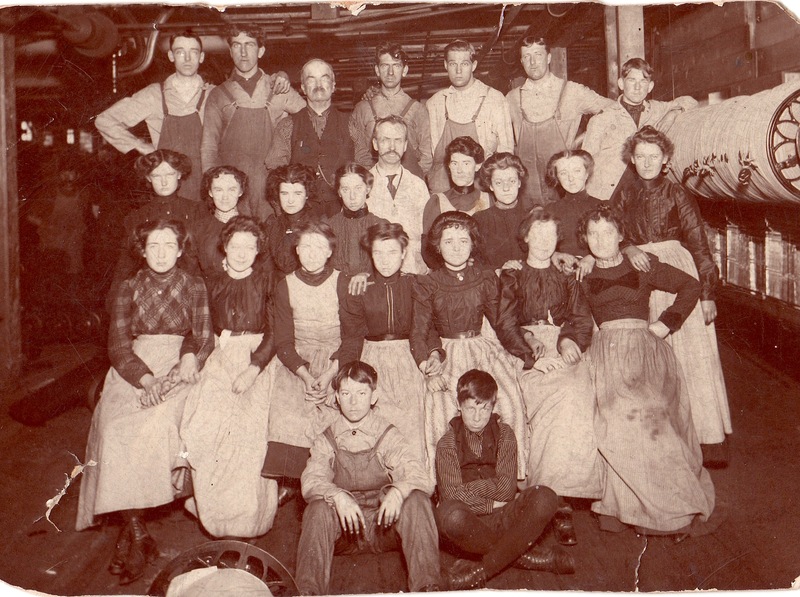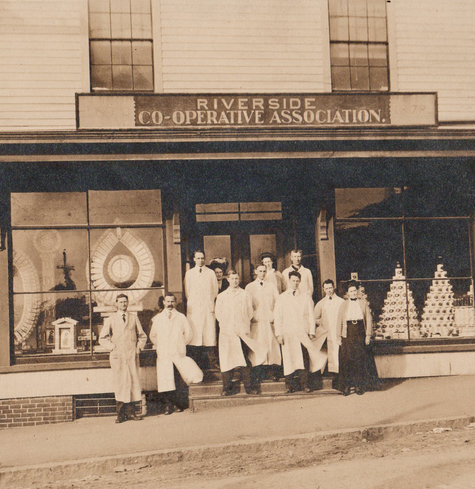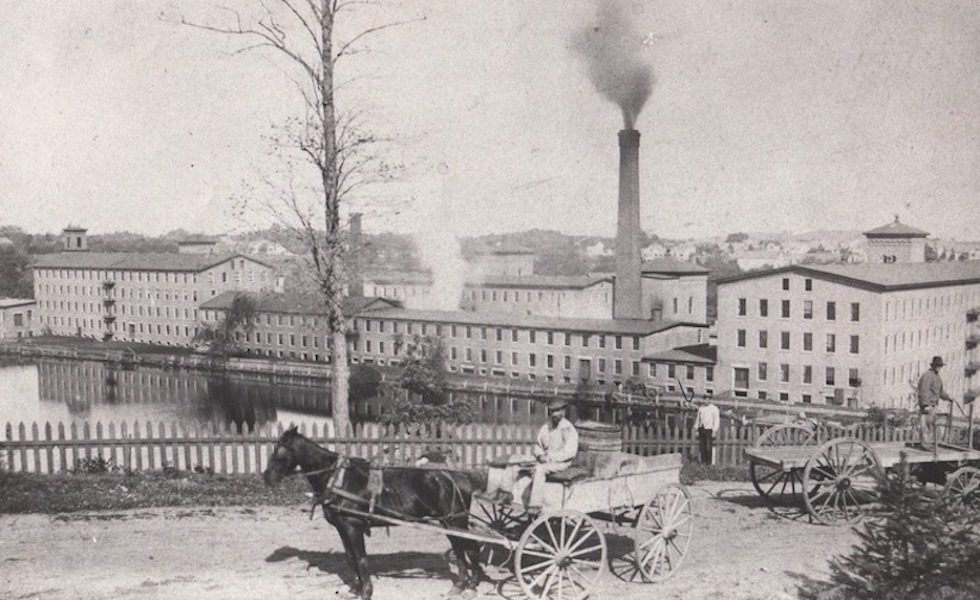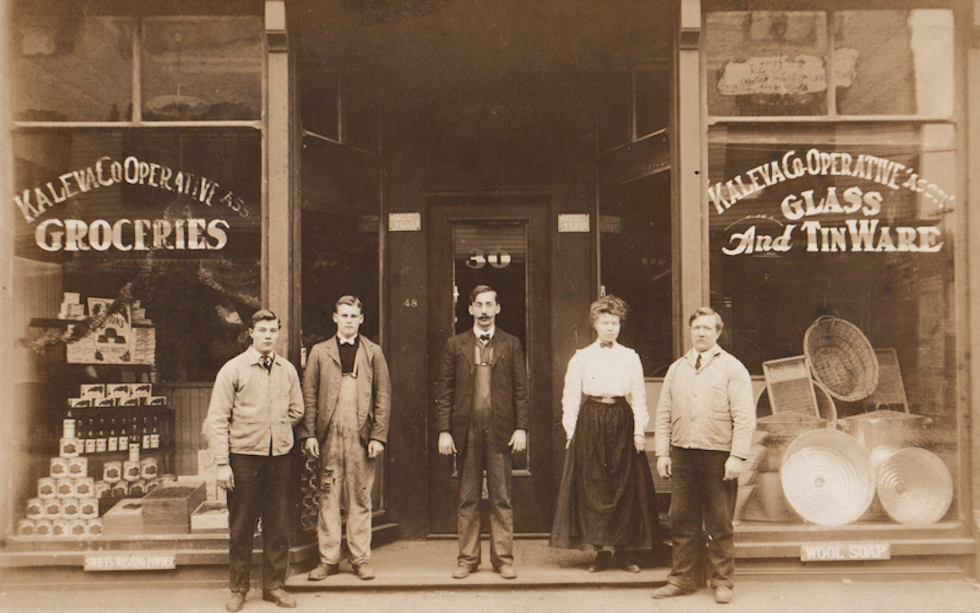The Assabet Mill in Maynard, 1881. Founded in 1847, the mill employed generations of immigrant workers for over a hundred years.
Home of the Nipmuc Indians, the area that would become Maynard was first settled by Puritans in the 1650s. Although the early settlers relied on agriculture, the town later industrialized, utilizing the Assabet River to create a hydraulic mill. Maynard’s economy soon became heavily reliant upon woolen manufacturing, prompting the local saying, “as the mill goes, so goes the town.” Immigrant workers and their families were critical to this story.

Incorporated in 1871, the town was named after Amory Maynard who founded the Assabet Mill in 1847. While it originally produced wool carpets and yarn, the mill transitioned to blanket production during the Civil War and later produced a wide variety of woolen fabrics. Irish Catholic families were among the mill’s earliest workers, and Amory Maynard donated funds in 1865 to help establish the town’s first Catholic Church, St. Bridget’s, for his growing workforce. Beginning in the 1880s, the mill became an economic draw for many other immigrant groups, including Finns, Poles, Lithuanians, Russians, Italians, Swedes, Norwegians, and Danes. By 1910, the foreign born made up nearly half of Maynard’s 6400 residents.
These workers initially lived along the river in small cottages and boarding houses built by the mill owners. After the vast American Woolen Company took over the mill in 1898, the company built 160 tenements for workers east of the mill in 1901-2 and then added more than 150 more homes in 1918 (most were auctioned off to private buyers in 1934). As Maynard’s immigrant communities grew, ethnic churches and organizations flourished. In 1910, St. Casmir’s Roman Catholic Church began to serve the Polish population which numbered more than 600, as did the Holy Annunciation Russian Orthodox Church, founded in 1917. Other local churches were founded by Finns, Danes, and Swedes, while Eastern European Jews established a synagogue, Rodoff Sholom, in 1909. Irish, Russian, and Scandinavian immigrants also established their own clubs and halls in town.
But perhaps no group in Maynard was as influential as the Finns. Fleeing discriminatory laws, heavy taxes, and military conscription under Russian Czar Nichols II, they began to migrate to the United States in large numbers, first settling in Maynard in the 1880s. According to a contemporary Finnish historian, in 1898 there were over 200 Finns living in Maynard, including both men and women who worked at the mill. The Elmwood area, just south of the mill, became a largely Finnish neighborhood in the early twentieth century. By 1940, almost 30 percent of Maynard’s population was Finnish.

The Finns organized themselves through many interconnected organizations, meeting in several halls as well as in five different saunas in town. Saunas had a long history in Finnish culture and were an important location where people of all ages could cleanse and socialize. There were also three Finnish halls divided by political leanings, each with an array of athletic clubs and dramatic societies. Socialists were well represented in the community, including in the Finnish Workingman’s Socialist Society and several co-operative associations and stores. Finnish immigrants also held festivals at nearby Vose’s Pond, complete with a band, theater, and sports that attracted thousands of attendees each summer.
The Finns and other immigrant groups continued to live and work in Maynard through World War II. But production at the woolen mill began declining in the 1930s, and operations shut down permanently in 1950. Seven year later, the Digital Equipment Corporation moved into one of the buildings and purchased the entire mill complex in 1974. In the 1990s, it became a multi-tenant office complex, housing dozens of companies, mostly in the technology industry.
As Maynard evolved from an ailing mill town to a high-tech business center, its foreign-born population dropped precipitously. In 2010, the town’s immigrant residents made up less than ten percent of the population, and most came from different parts of the world, such as Mexico, China, Brazil, and Haiti. Today Indian immigrants worship at the old St. Casimir Church, now home to St. Mary’s Indian Orthodox Church. Immigrants also own many successful restaurants and businesses in the town’s center. Meanwhile, inside the walls of the old mill complex, foreign-born tech workers now power the start-ups where immigrant woolen workers once toiled at the looms.
–Amanda Judah
Works Cited
Flanagan, Samantha. “Back to the Future: Maynard Continues to Look Forward.” MassTLC, March 16, 2020.
Interview with Roy Herlander by author, February 9, 2020, Maynard, Massachusetts.
Kotval, Zenia, John Mullin & Zeenat Karamchandani (2008) Partnerships and the Fiscal Implications of Planning and Development: A Case Study of Maynard, Massachusetts, Planning, Practice & Research, 23:4, 461-478.
Mark, David A. Hidden History of Maynard. History Press, 2014.
–“Maynard’s Cooperative Organizations,” Part I & II, March 2019; and Part III, April 10, 2019. Maynard Life Outdoors and Hidden History of Maynard.
—Maynard : History and Life Outdoors. History Press, 2011.
Maynard Historical Committee. History of Maynard, Massachusetts: 1871-1971. 1971.
John R. Mullin, “Development of the Assabet Mills in 19th Century Maynard,” Landscape Architecture and Regional Planning Faculty Publication Series, University of Massachusetts Boston, 1992.
Voogd, Jan. Maynard, Massachusetts : A House in the Village. History Press, 2007.
Note: All photographs are courtesy of the Maynard Historical Society Archives



